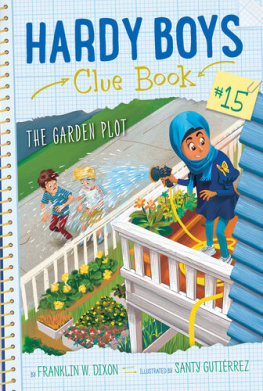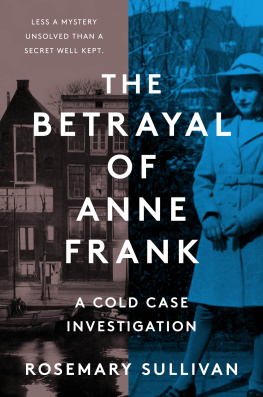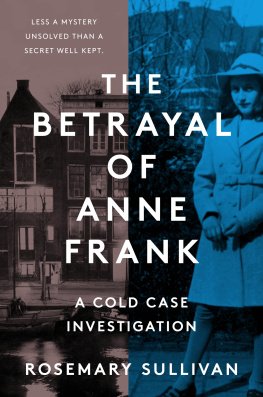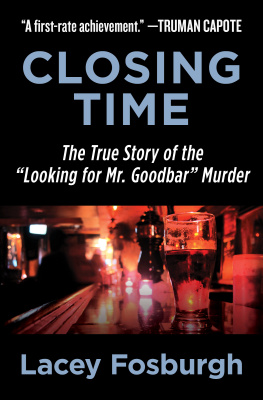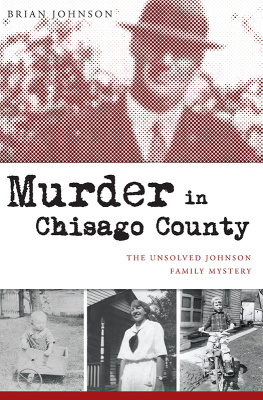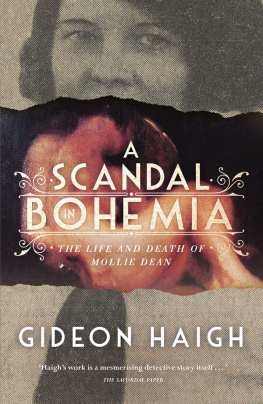


Published by The History Press
Charleston, SC
www.historypress.net
Copyright 2016 by Frank J. Leskovitz
All rights reserved
Front cover images from the personal collection of Beatrice Lynn Wilde.
First published 2016
e-book edition 2015
ISBN 978.1.62585.636.4
Library of Congress Control Number: 2015956013
print edition ISBN 978.1.46711.827.9
Notice: The information in this book is true and complete to the best of our knowledge. It is offered without guarantee on the part of the author or The History Press. The author and The History Press disclaim all liability in connection with the use of this book.
All rights reserved. No part of this book may be reproduced or transmitted in any form whatsoever without prior written permission from the publisher except in the case of brief quotations embodied in critical articles and reviews.
This book is dedicated to the memory of Miss May Fosburgh. So sweet was her musicand so tragic that it ended so soon.
May Lydia Fosburgh. Photograph from the personal collection of Beatrice Lynn Wilde.
Piano
Softly, in the dusk, a woman is singing to me;
Taking me back down the vista of years, till I see A child sitting under the piano, in the boom of the tingling strings And pressing the small, poised feet of a mother who smiles as she sings.
In spite of myself, the insidious mastery of song Betrays me back, till the heart of me weeps to belong To the old Sunday evenings at home, with winter outside And hymns in the cosy parlour, the tinkling piano our guide.
So now it is vain for the singer to burst into clamour With the great black piano appassionato. The glamour Of childish days is upon me, my manhood is cast Down in the flood of remembrance, I weep like a child for the past.
D.H. Lawrence
CONTENTS
COMMENTS AND ACKNOWLEDGEMENTS
The story that follows deals with one of the most sensational murder mysteries in Massachusetts history. It still remains unsolved today.
One of the hardest parts of dealing with such a newsworthy murder case in which all the major players are long dead is sorting out fact from fiction. While I believe Ive done a decent job of it, any errors within are mine and my responsibility alone.
Some words in the story are used interchangeably. An example of this would be nightgown and night dress. Another would be pistol, gun and revolver. The last name Fosburgh was very occasionally written as Fosburg in the press. I use Fosburgh throughout the book for consistency. This is how the name is spelled on the family grave markers, as well as the United States census data of the era. Robert S. Fosburghs middle name, Stuart, was frequently written incorrectly as Stewart. (Stuart was his mothers maiden name.)
Newspaper accounts figured significantly in this case, and I relied heavily on vintage accounts given in both the New York Times and the Berkshire Evening Eagle of Pittsfield, Massachusetts.
During the course of the trial, many questions were asked that may lead the reader to additional questions that unfortunately were never asked or clearly answered. I share in the readers frustration.
A Cast of Characters is included in the back of this book as an aid for the reader to keep track of the numerous individuals mentioned within.
Even when there are obvious errors in the testimony of individuals, I have left them as found. I have reached some personal conclusions about this sad tragedy, but Ill leave it entirely to the reader to sort it out and to reach his or her own conclusion. I would love to hear your opinion at fleskovitz@gmail.com.
Special thanks to all those who work at the Berkshire Athenaeum, Pittsfields fine public library. The library here has been a large part of my life since childhood. I would like to acknowledge the excellent assistance that I received there from Ann-Marie Harris and many others in the local history department.
I would like to acknowledge the assistance of Beatrice Lynn Wilde, the granddaughter of Beatrice Fosburgh, who aided me in confirming Fosburgh family history and generously shared photographs from her personal collection. Thank you, Lynn.
Thank you to Maryann Byrnes for taking numerous helpful photographs at the Fosburgh family plot at Woodlawn Cemetery in Bronx, New York.
Additional thanks to Lowell Paddock and Christine Paddock Foster for sharing information about their great-grandfather Dr. Franklin Kittredge Paddock.
I particularly value the input and clarifications that I received from several knowledgeable individuals who wish to remain anonymous. Your contributions are forever appreciated.
Valued thanks go to Tabitha Dulla for giving me the spark to write this story of the tragic death of Miss May L. Fosburgh.
Special gratitude goes to Elizabeth Farry and Karmen Cook, my editors at The History Press.
I would also like to thank the Pittsfield Police Department, Pittsfield City Hall, Pittsfield Cemetery and the Berkshire County Superior Court.
And finally, I especially would like to thank my family for all their love and support. I couldnt have done this without them.
A MURDER IN PITTSFIELD, MASSACHUSETTS
The small city of Pittsfield, Massachusetts, is centrally located in the Berkshire Hills of Western Massachusetts. The land encompassing Pittsfield was originally known as Pontoosuck, which is said to mean a field or haven for winter deer in the Mohican language. In 1761, the area was incorporated as the Township of Pittsfield. It was named after British politician William Pitt, who would eventually serve as the prime minister of Great Britain. At the time of incorporation, some 200 residents had settled in Pittsfield. After the Revolutionary War, the population grew to nearly 2,000 residents. Agriculture was the major focus in those early years. Abundant water from the Housatonic River and other sources served to attract industry to the area. These new mills produced lumber, grist, paper and textiles. Pittsfield would quickly become one of the major woolen manufacturers in the United States. By the late 1800s, the town was flourishing and would officially incorporate as the City of Pittsfield in 1891. Pittsfield eventually became the county seat and today is the largest community in Berkshire County. By 1900, the bustling city boasted a population of 21,766, which continued to increase with each passing day. (This number would peak at around 58,000 in 1960 and then gradually decrease to around 45,000 residents today.) The year 1900 began with the celebration of a new centuryone in which it seemed new inventions and opportunities were being created every day. It was a time of great progress for both the area and the nation.
The last quarter of the nineteenth century, the American Gilded Age was a time of unprecedented growth and possibilities. (The Gilded Age would also signify social conflict and a growing disparity between the rich and poor, particularly for newly arrived European immigrants.) The Berkshires quickly became a favorite summer destination of the rich and famous, much like Newport, Rhode Island, and Bar Harbor, Maine. Both Lenox and Stockbridge, Massachusetts, saw a great influx of New Yorks and Bostons most privileged society members, as well as those in the arts, particularly writers. They were drawn to the area by the beautiful scenery and pleasant summer weather. Many magnificent Berkshire cottages were constructed during this period. Today, the Berkshires remain very popular with tourists and artists alike.


